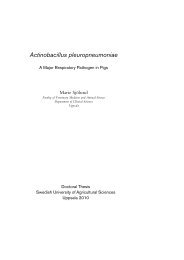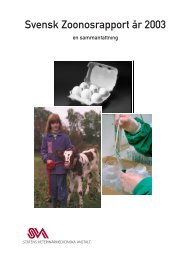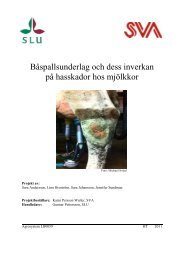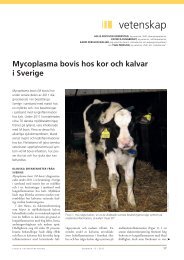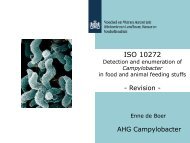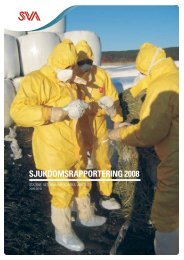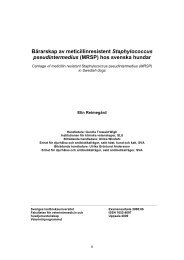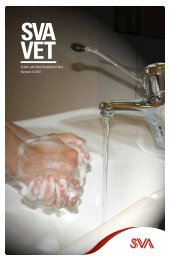Antimicrobial Resistance in Poultry Campylobacter jejuni ... - SVA
Antimicrobial Resistance in Poultry Campylobacter jejuni ... - SVA
Antimicrobial Resistance in Poultry Campylobacter jejuni ... - SVA
You also want an ePaper? Increase the reach of your titles
YUMPU automatically turns print PDFs into web optimized ePapers that Google loves.
Company<br />
LOGO<br />
ANTIMICROBIAL RESISTANCE IN<br />
POULTRY CAMPYLOBACTER JEJUNI<br />
ISOLATES FROM SLOVENIA<br />
Igor Gruntar, Majda Golob, Jasna Mićunovi<br />
unović, , Irena Zdovc<br />
National Veter<strong>in</strong>ary Institute<br />
Veter<strong>in</strong>ary faculty, , Institute of Microbiology and Parasitology<br />
2012 EURL- <strong>Campylobacter</strong> workshop, , Uppsala
1. 1. Intro<br />
2. 2. Materials and methods<br />
3. 3. Results and comparison to to EU situation<br />
4. 4. Conclusions
Introduction<br />
<strong>Campylobacter</strong> sp.:<br />
the most frequent<br />
bacterial cause of<br />
human <strong>in</strong>test<strong>in</strong>al<br />
<strong>in</strong>fections <strong>in</strong> EU<br />
Intest<strong>in</strong>al campylobacteriosis,<br />
the ma<strong>in</strong> causative agens:<br />
<strong>Campylobacter</strong> <strong>jejuni</strong><br />
- normal <strong>in</strong>habitant/commensal of<br />
poultry <strong>in</strong>test<strong>in</strong>es<br />
- common / regular poultry meat<br />
contam<strong>in</strong>ant<br />
Incidence (EFSA, 2010):<br />
- EU 45,57/100.000<br />
- SLO 46,84/100.000<br />
Aims:<br />
- to analise AMR trends <strong>in</strong> poultry C.<br />
<strong>jejuni</strong> isolates from various matrices <strong>in</strong><br />
2008 – 2011 <strong>in</strong> Slovenia<br />
The problem:<br />
- <strong>in</strong>cidence is <strong>in</strong>creas<strong>in</strong>g<br />
- C. <strong>jejuni</strong> antimicrobial resistance<br />
(AMR) is <strong>in</strong>creas<strong>in</strong>g<br />
- Especially qu<strong>in</strong>olones<br />
- Especially Central and South Europe.
Materials and methods<br />
Isolates<br />
Orig<strong>in</strong><br />
Method<br />
339 339 C. C. <strong>jejuni</strong> <strong>jejuni</strong>isolates<br />
isolates<br />
-<br />
-<br />
broiler<br />
broiler<br />
caecal<br />
caecal<br />
contents<br />
contents<br />
(faeces;<br />
(faeces;<br />
n = 110)<br />
110)<br />
-<br />
-<br />
broiler<br />
broiler<br />
carcasses<br />
carcasses<br />
dur<strong>in</strong>g<br />
dur<strong>in</strong>g<br />
slaughter<strong>in</strong>g<br />
slaughter<strong>in</strong>g<br />
(sk<strong>in</strong>;<br />
(sk<strong>in</strong>;<br />
n = 117)<br />
117)<br />
-<br />
-<br />
broiler<br />
broiler<br />
meat,<br />
meat,<br />
before<br />
before<br />
refrigeration<br />
refrigeration<br />
(n<br />
(n<br />
= 112)<br />
112)<br />
--2008: 2008: BS BS Salmonella, Salmonella,<br />
<strong>Campylobacter</strong><br />
<strong>Campylobacter</strong><br />
--2009 2009 – 2011: 2011: national national<br />
<strong>Campylobacter</strong><br />
<strong>Campylobacter</strong><br />
monitor<strong>in</strong>g monitor<strong>in</strong>gprogram <strong>in</strong> <strong>in</strong><br />
broilers broilers<br />
--VARS VARS --coord<strong>in</strong>ated<br />
coord<strong>in</strong>ated<br />
--MIC: MIC: m<strong>in</strong>imal m<strong>in</strong>imal<strong>in</strong>hibitory<br />
<strong>in</strong>hibitory<br />
concentration<br />
concentration<br />
--breakpo<strong>in</strong>ts breakpo<strong>in</strong>tsaccord<strong>in</strong>g accord<strong>in</strong>gto<br />
to<br />
EUCAST EUCAST // AMR-EuRL AMR-EuRLcriteria<br />
--EUCAMP EUCAMP Sensititre Sensititreplates<br />
(TREK (TREK Diagnostics)<br />
Diagnostics)<br />
--ciprofloxac<strong>in</strong>, ciprofloxac<strong>in</strong>, nalidixic nalidixicacid,<br />
acid,<br />
tetracycl<strong>in</strong>e, tetracycl<strong>in</strong>e, gentamic<strong>in</strong>, gentamic<strong>in</strong>,<br />
erythromyc<strong>in</strong>,<br />
erythromyc<strong>in</strong>,<br />
chloramphenicol chloramphenicoland<br />
and<br />
streptomyc<strong>in</strong><br />
streptomyc<strong>in</strong>
Results<br />
I<br />
2008<br />
EU<br />
2008 2008<br />
2009<br />
SLO<br />
SLO<br />
average<br />
2010<br />
SLO<br />
2011<br />
SLO<br />
% R<br />
% R<br />
% R<br />
% R<br />
% R<br />
CIP 50,0<br />
NAL 51,0<br />
TC 37,0<br />
GM 4,0<br />
ERY 3,0<br />
CHL -<br />
STR -<br />
CIP 72,2<br />
NAL 64,9<br />
TC 32,0<br />
GM 2,1<br />
ERY 0,0<br />
CHL 0,0<br />
STR 4,1<br />
CIP 85,1<br />
NAL 58,1<br />
TC 64,8<br />
GM 0,0<br />
ERY 0,0<br />
CHL 0,0<br />
STR 2,7<br />
CIP 78,0<br />
NAL 46,0<br />
TC 56,0<br />
GM 0,0<br />
ERY 0,0<br />
CHL 0,0<br />
STR 3,0<br />
CIP 91,2<br />
NAL 70,6<br />
TC 51,5<br />
GM 2,9<br />
ERY 2,9<br />
CHL 0,0<br />
STR 2,9
Results II<br />
<strong>Antimicrobial</strong> resistance <strong>in</strong> C. <strong>jejuni</strong> <strong>in</strong> broilers<br />
from Slovenia; 2008-2011<br />
100,0<br />
% R<br />
90,0<br />
80,0<br />
70,0<br />
60,0<br />
50,0<br />
40,0<br />
30,0<br />
20,0<br />
10,0<br />
ciprofloxac<strong>in</strong> - EU average 2008<br />
tetracycl<strong>in</strong>e - EU average 2008<br />
nalidixic acid - EU average 2008<br />
gentam ic<strong>in</strong><br />
ciprofloxac<strong>in</strong> - all sam ples<br />
ciprofloxac<strong>in</strong> - fecal sam ples<br />
ciprofloxac<strong>in</strong> - sk<strong>in</strong> and m eat sam ples<br />
tetracycl<strong>in</strong>e - all sam ples<br />
tetracycl<strong>in</strong>e - fecal sam ples<br />
tetracycl<strong>in</strong>e - sk<strong>in</strong> and m eat sam ples<br />
erythrom ic<strong>in</strong><br />
nalidixic acid - all s am ples<br />
nalidixic acid - fecal sam ples<br />
nalidixic acid - sk<strong>in</strong> and m eat sam ples<br />
chloram phenicol<br />
streptom yc<strong>in</strong><br />
ciprofloxac<strong>in</strong> - hum ans SLO<br />
tetracycl<strong>in</strong>e - hum ans SLO<br />
nalidixic acid - hum ans SLO<br />
0,0<br />
-10,0<br />
2008 2009 2010 2011<br />
Year
Results III<br />
<strong>Antimicrobial</strong> resistance <strong>in</strong> C. <strong>jejuni</strong> <strong>in</strong> broilers<br />
from Slovenia; 2008-2011<br />
100,0<br />
90,0<br />
80,0<br />
% R<br />
70,0<br />
60,0<br />
50,0<br />
40,0<br />
30,0<br />
20,0<br />
10,0<br />
ciprofloxac<strong>in</strong> - EU average 2008<br />
tetracycl<strong>in</strong>e - EU average 2008<br />
nalidixic acid - EU average 2008<br />
gentam ic<strong>in</strong><br />
ciprofloxac<strong>in</strong> - all s am ples<br />
tetracycl<strong>in</strong>e - all s am ples<br />
erythrom ic<strong>in</strong><br />
nalidixic acid - all s am ples<br />
chloram phenicol<br />
s treptom yc<strong>in</strong><br />
ciprofloxac<strong>in</strong> - hum ans SLO<br />
tetracycl<strong>in</strong>e - hum ans SLO<br />
nalidixic acid - hum ans SLO<br />
0,0<br />
-10,0<br />
2008 2009 2010 2011<br />
Year
Situation <strong>in</strong> EU (EFSA 2010)<br />
2011: 88,7 % !!!<br />
2011: 70,6 % !!! 2011: 44,5 %<br />
2nd place 3rd place 1st place
Situation <strong>in</strong> EU (EFSA 2010) – C. <strong>jejuni</strong>,<br />
broiler feces, AMR aga<strong>in</strong>st different ABs<br />
SLO 2011: 95 % !!! SLO 2011: 70 % !!! SLO 2011: 65 % !!!
Situation <strong>in</strong> EU (EFSA 2010) – TC, trends<br />
2011
Situation <strong>in</strong> EU (EFSA 2010) - CIP<br />
under 20 %<br />
SLO 2011<br />
~ 50 %<br />
under 20 %<br />
more than 80 %
Situation <strong>in</strong> EU (EFSA 2010) - CIP
Situation <strong>in</strong> EU (EFSA 2010) – C. coli, TC, pigs
Situation <strong>in</strong> EU (EFSA 2010) – C. <strong>jejuni</strong><br />
SLO 2011: 95 % !!! SLO 2011: 88,7 % !!!
Company<br />
LOGO<br />
ANTIMICROBIAL RESISTANCE IN<br />
POULTRY CAMPYLOBACTER JEJUNI<br />
ISOLATES FROM SLOVENIA: CONCLUSIONS<br />
• Irrespectively<br />
of the type of sample, from which they were isolated and <strong>in</strong><br />
accordance with the results from other EU countries, the antibiotic tic resistance <strong>in</strong><br />
poultry C. <strong>jejuni</strong> isolates from Slovenia is most commonly found aga<strong>in</strong>st three<br />
antibiotics: ciprofloxac<strong>in</strong>, nalidixic acid and tetracycl<strong>in</strong>e.<br />
• <strong>Resistance</strong> rate to these antibiotics is substantially above the European<br />
average and with an 2010-2011 2011 upward trend <strong>in</strong> case of both qu<strong>in</strong>olones.<br />
• The worst situation recorded was for 2011 C. <strong>jejuni</strong> faecal stra<strong>in</strong>s, when 95%<br />
resistance rate to ciprofloxac<strong>in</strong>, 70% resistance rate to nalidixic acid and 65%<br />
resistance rate to tetracycl<strong>in</strong>e was recorded<br />
• <strong>Resistance</strong> was very rarely observed aga<strong>in</strong>st erythromyc<strong>in</strong>, gentamic<strong>in</strong>,<br />
chloramphenicol and streptomyc<strong>in</strong>: <strong>in</strong> this area Slovenian isolates ma<strong>in</strong>ta<strong>in</strong> good<br />
sensitivity and fall below the European average.
Company<br />
LOGO<br />
ANTIMICROBIAL RESISTANCE IN<br />
POULTRY CAMPYLOBACTER JEJUNI<br />
ISOLATES FROM SLOVENIA<br />
Do we agree that …<br />
… C. <strong>jejuni</strong> resistance to ciprofloxac<strong>in</strong>, tetracycl<strong>in</strong>e and<br />
nalidixic acid has reached alarm<strong>in</strong>g proportions <strong>in</strong><br />
Slovenia ?<br />
… reasons for such a high percentage of resistant isolates<br />
should be further <strong>in</strong>vestigated, <strong>in</strong>clud<strong>in</strong>g the possibility of<br />
<strong>in</strong>apropriate use of antibiotics <strong>in</strong> poultry production<br />
… C. <strong>jejuni</strong> AMR studies needed <strong>in</strong> EFSA non-report<strong>in</strong>g<br />
countries ?<br />
… C. <strong>jejuni</strong> might be used as a sent<strong>in</strong>el/<strong>in</strong>dicator<br />
<strong>in</strong>dicator bacterium<br />
to detect the <strong>in</strong>creas<strong>in</strong>g AMR on a farm/region<br />
region/country<br />
?
Time … is runn<strong>in</strong>g out …


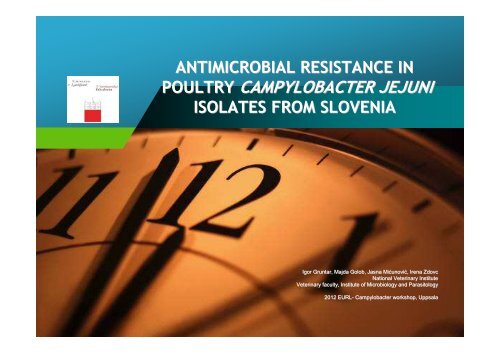
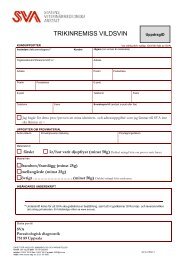
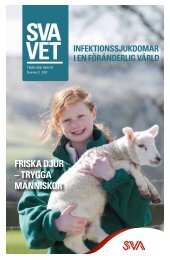
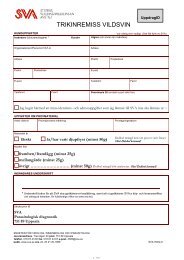
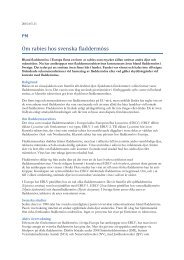
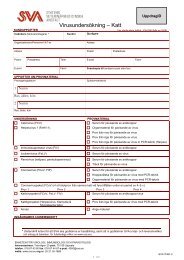
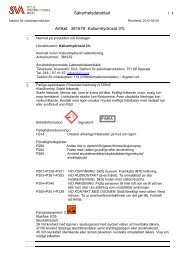
![Uppsala nfo z NRL pro kampylobaktery .ppt [režim kompatibility] - SVA](https://img.yumpu.com/48904877/1/190x135/uppsala-nfo-z-nrl-pro-kampylobaktery-ppt-rea-3-4-im-kompatibility-sva.jpg?quality=85)
